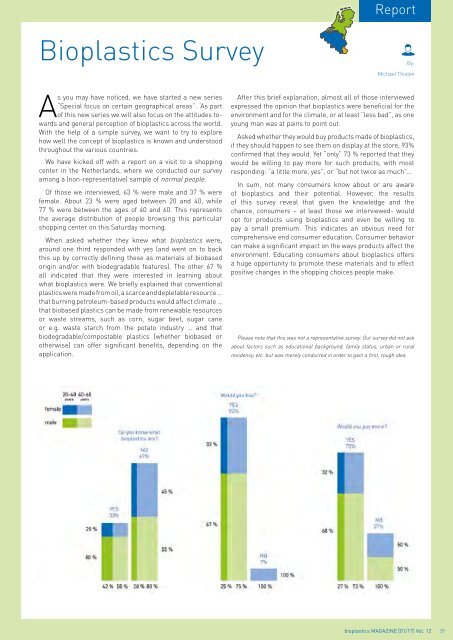Issue 01/2017
bioplasticsMAGAZINE_1701
bioplasticsMAGAZINE_1701
Create successful ePaper yourself
Turn your PDF publications into a flip-book with our unique Google optimized e-Paper software.
Report<br />
Bioplastics Survey<br />
By:<br />
Michael Thielen<br />
As you may have noticed, we have started a new series<br />
“Special focus on certain geographical areas”. ‘As part<br />
of this new series we will also focus on the attitudes towards<br />
and general perception of bioplastics across the world.<br />
With the help of a simple survey, we want to try to explore<br />
how well the concept of bioplastics is known and understood<br />
throughout the various countries.<br />
We have kicked off with a report on a visit to a shopping<br />
center in the Netherlands, where we conducted our survey<br />
among a (non-representative) sample of normal people.<br />
Of those we interviewed, 63 % were male and 37 % were<br />
female. About 23 % were aged between 20 and 40, while<br />
77 % were between the ages of 40 and 60. This represents<br />
the average distribution of people browsing this particular<br />
shopping center on this Saturday morning.<br />
When asked whether they knew what bioplastics were,<br />
around one third responded with yes (and went on to back<br />
this up by correctly defining these as materials of biobased<br />
origin and/or with biodegradable features). The other 67 %<br />
all indicated that they were interested in learning about<br />
what bioplastics were. We briefly explained that conventional<br />
plastics were made from oil, a scarce and depletable resource …<br />
that burning petroleum-based products would affect climate …<br />
that biobased plastics can be made from renewable resources<br />
or waste streams, such as corn, sugar beet, sugar cane<br />
or e.g. waste starch from the potato industry … and that<br />
biodegradable/compostable plastics (whether biobased or<br />
otherwise) can offer significant benefits, depending on the<br />
application.<br />
After this brief explanation, almost all of those interviewed<br />
expressed the opinion that bioplastics were beneficial for the<br />
environment and for the climate, or at least “less bad”, as one<br />
young man was at pains to point out.<br />
Asked whether they would buy products made of bioplastics,<br />
if they should happen to see them on display at the store, 93%<br />
confirmed that they would. Yet “only” 73 % reported that they<br />
would be willing to pay more for such products, with most<br />
responding: “a little more, yes”, or “but not twice as much”…<br />
In sum, not many consumers know about or are aware<br />
of bioplastics and their potential. However, the results<br />
of this survey reveal that given the knowledge and the<br />
chance, consumers – at least those we interviewed- would<br />
opt for products using bioplastics and even be willing to<br />
pay a small premium. This indicates an obvious need for<br />
comprehensive end consumer education. Consumer behavior<br />
can make a significant impact on the ways products affect the<br />
environment. Educating consumers about bioplastics offers<br />
a huge opportunity to promote these materials and to effect<br />
positive changes in the shopping choices people make.<br />
Please note that this was not a representative survey. Our survey did not ask<br />
about factors such as educational background, family status, urban or rural<br />
residency, etc. but was merely conducted in order to gain a first, rough idea.<br />
bioplastics MAGAZINE [<strong>01</strong>/17] Vol. 12 39


















